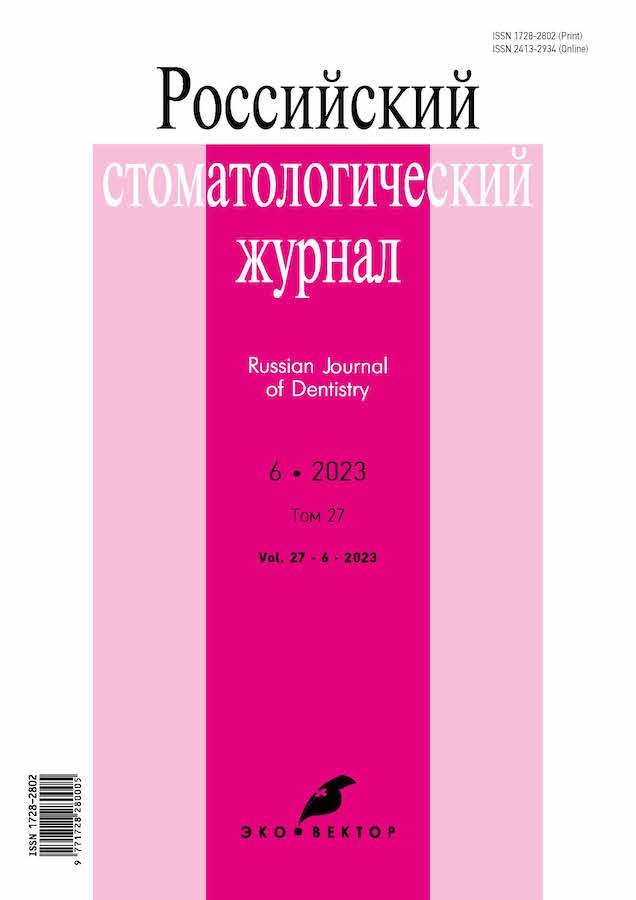The use of raman-fluorescent medical technologies to assess the effect of physical and chemical factors on the mineralization of hard tooth tissues in normal and noncarious lesions
- Authors: Aleksandrov M.T.1, Podoynikova M.N.1, Eganian D.G.1
-
Affiliations:
- Moscow Regional Research Clinical Institute named after M.F. Vladimirsky
- Issue: Vol 27, No 6 (2023)
- Pages: 521-531
- Section: Clinical Investigations
- Submitted: 17.07.2023
- Accepted: 19.02.2024
- Published: 26.03.2024
- URL: https://rjdentistry.com/1728-2802/article/view/508778
- DOI: https://doi.org/10.17816/dent508778
- ID: 508778
Cite item
Abstract
BACKGROUND: Assessment of the rapid state of mineralization of hard tooth tissues in normal and in various carious and noncarious lesions based on objective in situ methods is an unsolved and urgent issue in dental science and practice.
AIM: To substantiate the need for the clinical application in situ of express digital raman-fluorescent technology to increase the objectivity and effectiveness of assessing the degree of mineralization of hard tooth tissues in carious (initial form) and noncarious (wedge-shaped defect, pathological erasability) lesions under the influence of various physical and chemical factors on tissues.
MATERIALS AND METHODS: A survey of 80 patients aged 25–50 years was conducted; the patients were divided into three groups: comparison and with carious and with noncarious (wedge-shaped defect, pathological erasability) lesions of hard dental tissues. In each group, changes in hygienic conditions and mineralization parameters of hard tooth tissues were assessed by the difference in the spectral intensity of raman-fluorescent measurements before and after controlled and/or uncontrolled hygienic treatment. Previously, under experimental conditions, the effects of various physical (mechanical processing, X-ray irradiation on the LNK-268 installation) and chemical (citric acid, hydroxylapatite (GAP) dry and moistened) factors on the hard tissues of the tooth were studied. Simultaneously, “locally” in real time, the mineralization parameters of the hard tissues of the tooth were recorded before and after hygienic treatment. In this study, we used an installation of the “InSpectrM” type in our modification.
RESULTS: Experimental studies have shown the effectiveness and objectivity of the use of raman-fluorescence diagnostics to assess the hygienic condition and mineralization of hard dental tissues. The objectivity of the assessment of mineralization in a moistened state was investigated (dry GAP, 702 rel. units; wet GAP, 1520 rel. units), and the absence of the effect of radiation on the mineralization of hard tissues of the teeth (p >0.95) was revealed.
Clinical observations showed that in patients with a wedge-shaped defect and increased erasability of hard tooth tissues, the hygienic condition is 5–10% worse than that in patients with intact tooth tissues and initial formation of caries. The main difference in the condition of hard tissues of teeth with noncarious lesions is a statistically significantly reduced (p >0.95) mineralization of hard tissues of the tooth, requiring remineralizing therapy immediately after hygienic treatment.
CONCLUSION: In experimental and clinical conditions, the objectivity and effectiveness of the use of express raman-fluorescent technologies to assess the mineralization of hard tooth tissues when exposed to various physical and chemical factors in normal conditions, with carious (initial form) and noncarious (wedge-shaped defect, pathological erasability) lesions, are substantiated.
Full Text
About the authors
Mikhail T. Aleksandrov
Moscow Regional Research Clinical Institute named after M.F. Vladimirsky
Author for correspondence.
Email: alex_mta@mail.ru
ORCID iD: 0000-0003-2777-296X
MD, Dr. Sci. (Medicine), Professor
Russian Federation, MoscowMaria N. Podoynikova
Moscow Regional Research Clinical Institute named after M.F. Vladimirsky
Email: podoinikova_mary@mail.ru
ORCID iD: 0009-0009-7504-2321
MD, Dr. Sci. (Medicine), Associate Professor
Russian Federation, MoscowDavid G. Eganian
Moscow Regional Research Clinical Institute named after M.F. Vladimirsky
Email: eganyandavid@mail.ru
ORCID iD: 0009-0008-6405-4207
Russian Federation, Moscow
References
- Alexandrov MT. Laser clinical biophotometry (theory, experiment, practice). Moscow: Technosphere; 2008, 583 p. (In Russ.) EDN: QLRHVR
- Bezhanishvili GG, Shirshikova AA, Alykhova ND, et al. Features of the treatment of medium and deep caries. Mezhdunarodnyj studencheskij nauchnyj vestnik. 2018;(1):19. EDN: YQLAUL
- Khomenko L, Sorochenko G, Ostapko E, et al. Experimental justification of mineralization processes’ control for permanent teeth’ enamel. Sovremennaja stomatologija. 2020;(1):48–53. EDN: ILFPSG
- Abduazimova LA, Mukhtоrova MM. Assessment of the state of caries incidence in children. Vestnik nauki i obrazovanija. 2021;(13-2):16–22. EDN: VWJNAN doi: 10.24411/2312-8089-2021-11303
- Kasiev N, Li N. Aspects of organization of dental caries prevention in children of school age. Bulletin of Science and Practice. 2021;7(1):178–187. EDN: THQOHT doi: 10.33619/2414-2948/62/18
- Ulitovskiy SB, Kalinina OV. The prevalence of noncarious teeth injury in pregnant and their interaction with ecology of oral cavity. Ekologiya cheloveka (Human Ecology). 2019;26(8):58–64. EDN: QTJBOR doi: 10.33396/1728-0862-8-58-64
- Aleksandrov MT, Olesova VN, Dmitrieva EF, et al. Integrated assessment of hygienic condition of the oral cavity. Stomatology. 2020;99(4):21–26. EDN: LTSRGT
- Aleksandrov MT, Gunko VI, Pashkov EP, et al. The use of laser-conversion diagnostics in dentistry (review). In: Scientific-practical conference of the Student Scientific Society of the Faculty of Dentistry, dedicated to the memory of Academician of the Russian Academy of Medical Sciences, Professor Bazhanov N.N. Moscow: MGMU im. I.M. Sechenova; 2011. (In Russ.)
- Alexandrov MT, Vorobyov AA, Pashkov EP, et al. The use of laser fluorescence to assess the hygienic state of the oral cavity. Annals of the Russian Academy of Medical Sciences. 2003(9):39–44.
- Mashima I, Theodorea CF, Thaweboon B, et al. Exploring the salivary microbiome of children stratified by the oral hygiene index. PLoS One. 2017;12(9):e0185274. doi: 10.1371/journal.pone.0185274
Supplementary files












